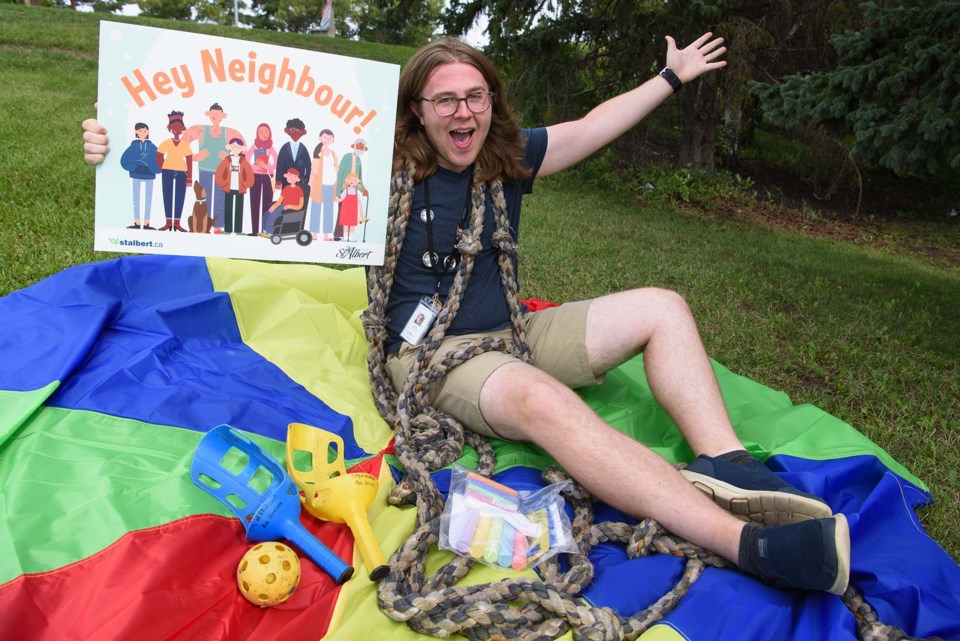Neighbours for climate
The Gazette is using the City of Edmonton’s Neighbouring for Climate guide to help St. Albert streets fight back against climate change. Check out the guide at edmonton.ca/climateneighbours.
When Tracy Kociuba had to rush her father to the hospital 10 years ago, she knew she could count on her neighbours to help.
“Without even making a single phone call, my neighbourhood all just leapt into action,” said the Lacombe Park resident.
Dinners popped up on her doorstep. Neighbours made sure her kids got to school safe. Later, her son would tell her how he never realized so many people on his street loved him.
“That unto itself tells you why you have to be a good neighbour,” Kociuba said.
Climate change is a community problem. When blazing heat, choking smoke, creeping floods, and shocking food prices come to our doors, the first people you’re likely to ask for help are your neighbours.
The City of Edmonton launched its Neighbouring for Climate guide earlier this year as a way to help neighbourhoods adapt to the impacts of global heating. The guide contains tips that can apply to any street in North America. Over the next few months, the Gazette will look at how St. Albert residents can use this guide and the power of community to take on the climate challenge.
The answer is local
Global heating makes extreme weather more likely, and with it floods, fires, and other natural disasters.
Emergency responders might not get to you in time in those situations, said Cara Parenteau, project associate with the City of St. Albert’s Family and Community Support Services program.
“In an emergency or a disaster, we do know that neighbours are often the first people to respond on a local level.”
Working with neighbours on climate issues enhances feelings of safety and improves our ability to respond to emergencies, the Neighbouring for Climate guide says.
Kociuba and her neighbours have taken many steps to protect against climate emergencies. They distribute seeds for garden contests, for example, growing local food that protects them from agricultural disaster. They also check in on each other during emergencies. When a heat wave washes through her street, Kociuba knows to invite heat-vulnerable neighbours over for coffee and the safety of her air-conditioned house.
Kociuba said her neighbours stay in touch through Facebook, mass emails, and a common emergency contact list. These connections let them easily organize games of street hockey or runs to the compost dump, and react quickly during emergencies, such as the time a burglar was spotted on their street.
“With a couple of keystrokes, I had the whole neighbourhood locked down,” Kociuba said.
Research supports the idea that connections create climate resilience. One study of the 1995 Chicago heat wave found people in connected communities were more likely to have survived that event than those in isolated ones because connected residents knew which people needed help.
Getting organized
Block parties are an excellent way to forge neighbourhood connections. About half of St. Albert’s streets have held a block party since 2008, the City of St. Albert reports. Such gatherings help residents learn who has what needs during an emergency, and who has the skills to address them, the Neighbouring for Climate guide notes.
Kociuba said she and her husband started their neighbourhood block party about 22 years ago with a simple barbecue. Now, they hold at least one big block party a year and various smaller get-togethers.
The City of St. Albert offers detailed guides on block parties, as well as ways to get free food and party toys. The St. Albert Public Library also has Neighbourhood Connections kits which encourage people to get to know their neighbours by going on bug, bird, and plant walks.
Kociuba advised new block partiers to start simple.
“It doesn’t have to be big. Our block party was originally just six people.”
Once you’ve had your party, have guests write down their contact information so they can reach each other during an emergency, Parenteau said. You can also use that contact list for mundane tasks like telling people they’ve left their garage open.
Kociuba said bigger projects such as the city’s seed library, the former tool library, and the Lacombe Park Garden and Connection Place all came about from passionate residents making connections with their neighbours.
“It was just somebody had a passion, and they were willing to share that passion and that talent.”
Anyone interested in block parties can come out for Good Neighbour Day on Aug. 26 at the Lacombe Clubhouse (145 Larose Drive), where organizers will offer free food and games to bolster neighbourhood connections. Visit stalbert.ca/events/calendar/community/good-neighbour-day-2023 for details.




